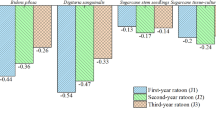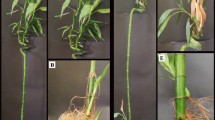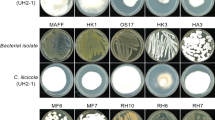Abstract
IN 1952, I reported1 the inhibition in vitro of the crown-rot fungus, Sclerotium delphinii Welch, by two species of Penicillium, P. brevi-compactum and P. charlesii. In vivo experiments were set up to demonstrate the practical utilization of these penicillia as agents in combating the crown-rot fungus disease. For this purpose the penicillia were grown in large quantities in Czapek–Dox medium for seventeen to eighteen days on a rotary shaker at room temperature. The culture fluid was then filtered and the filtrate was poured into standard greenhouse flats, containing soil which had been artificially infested three days before with sclerotia of S. delphinii. Controls were also set up, using Czapek–Dox medium, in flats of similarly infested soil. A few days after filtrates of different concentrations were added to the flats, nine plants of Mazus reptans and Ajuga reptans (two rock-garden plants extremely susceptible to S. delphinii) were planted in each of the different flats.
This is a preview of subscription content, access via your institution
Access options
Subscribe to this journal
Receive 51 print issues and online access
$199.00 per year
only $3.90 per issue
Buy this article
- Purchase on Springer Link
- Instant access to full article PDF
Prices may be subject to local taxes which are calculated during checkout
Similar content being viewed by others
References
Joseph, T. C., Nature, 169, 1016 (1952).
Author information
Authors and Affiliations
Rights and permissions
About this article
Cite this article
JOSEPH, T. Inhibition of the Crown-rot Disease Fungus, Sclerotium delphinii Welch. Nature 173, 1144–1145 (1954). https://doi.org/10.1038/1731144a0
Issue Date:
DOI: https://doi.org/10.1038/1731144a0
This article is cited by
-
Possibility of using a bacterial antagonist against fungal diseases of Piper betle L. and corchorus spp.
Mycopathologia et Mycologia Applicata (1965)
Comments
By submitting a comment you agree to abide by our Terms and Community Guidelines. If you find something abusive or that does not comply with our terms or guidelines please flag it as inappropriate.



